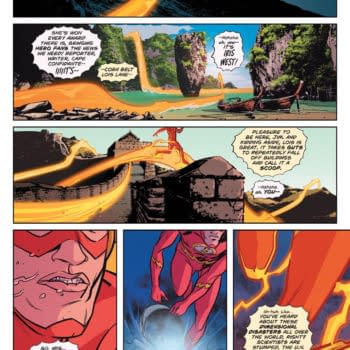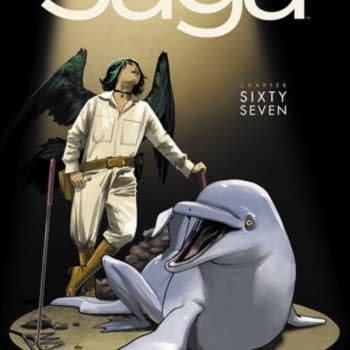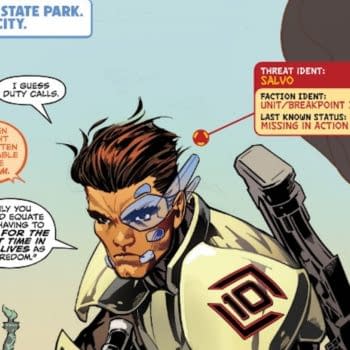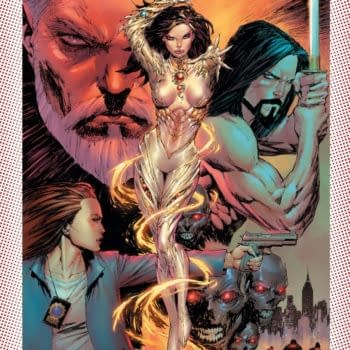Posted in: Comics, Recent Updates | Tagged: archie comics, Archie Vs. Predator #1, Ares & Aphrodite: Love Wars, Convergence Titles, dc comics, Godzilla: Rulers Of Earth Vol. 5, idw, oni press
Thor's Comic Review Column – Ares & Aphrodite: Love Wars, Convergence Titles, Archie Vs. Predator #1, Godzilla: Rulers Of Earth Vol. 5
This weeks' reviews:
Ares & Aprodite: Love Wars
Convergence #2
Convergence: JLI #1
Convergence Suicide Squad #1
Convergence Green Arrow #1
Convergence Supergirl: Matrix #1
Archie Vs. Predator #1
Godzilla: Rulers of Earth Vol. 5
Ares & Aprodite: Love Wars (Oni Press)
By Bart Bishop

Will Ares is a successful divorce lawyer that has been getting death threats recently. A brick was thrown through his windshield, stuffed animals with severed heads have been mailed to his apartment, and he's scared stiff. When he finds himself working alongside Gigi Averelle because of mutual clients, the movie producer Evans Beatty and up-and-coming Hollywood sweetheart Carrie Cartwright, the two can't help but falling in love and in usual romantic comedy fashion denying the attraction. This leads to a bet between the two on whether or not Evans and Carrie will stay together when faced with paparazzi scandal. Surprisingly Will is out to prove that they will stay together, thus proving that love does exist. Gigi, the woman immersed in the wedding industry, is a cynic and takes the other side, having lost all faith in finding "the one" some day. Shenanigans result.
Rich knows character. He's able to imbue complexity, although sometimes he falls back on a few old chestnuts. For instance, there's their names. Ares, god of war and Aphrodite, goddess of love. Get it?! Yet it's a simple touch that mostly goes unacknowledged. There's the aforementioned fact that Will is the optimist and Gigi is the pessimist, but there's also simple signifiers like him owning a cat and she owns a dog. It's cliché, but it works: they're both lonely and want companions, cat people are a bit more aloof, dog people are a bit more fun. These are the kinds of things that can land like a brick with those outside the know, but for pet owners (I have both a cat and a dog) it's a shorthand that communicates so much. So maybe I'm an easy lay here? Beyond that, however, there's little touches like Will clinging to a golf club, scared of the knocking at his front door in the middle of the night, or how Evans and Carrie could have walked out of the tabloids but are given layers of their own.
Levens's art is a fun change of pace. When it comes to comic book art, there's often a push and pull between representation and illustration. Cartoons are generally known for being representational, more exaggerated and in line with caricature. Comic books, however, often rely on the harder edge of aiming for realism, and therefore fall back on illustration too often. The problem is that comic books, without the benefit of motion or sound, need to make a big impression with only the visual resource, but Leven understands how to convey emotion and humor while tapping into an honesty and truth. She also has a keen eye for fashion, conveying a contemporary sensibility, and also isn't afraid to play up the sex appeal not just of Gigi but Will, as well. A segment showing their morning routine, contrasted side by side, goes a long way toward highlighting the differences and similarities between the sexes, and is tantalizing without exploitation. The only complaint is that there's a bit of digital sheen that can make panels appear waxy and static at times.
This graphic novel doesn't wear out its welcome. It's a one and done, very charming and mostly it's cute, a word that doesn't always grab the average comic reader's attention but, in this case, should.
Editor and teacher by day, comic book enthusiast by night, Bart has a background in journalism and is not afraid to use it. His first loves were movies and comic books, and although he grew up a Marvel Zombie he's been known to read another company or two. Married and with a newborn baby girl, he sure hopes this whole writing thing makes him independently wealthy someday. Bart can be reached at bishop@mcwoodpub.com.
Convergence Week 2
By Graig Kent
I've read more than my fair share of DC's event books — most of them, in fact– and I won't say Convergence is the worst of them, because some of them are really, really bad (Millennium, Bloodlines, and especially Genesis, I'm looking at you). But Convergence isn't great. The idea of pitting heroes against each other…not just heroes but entire cities of heroes… forcing them to destroy one another, it's not an outright bad idea, because no idea is a bad idea if it's executed well.
Jonathan Hickman's New Avengers recently dealt with parallel Earths having to fight for survival, lest they both be destroyed. There, parallel Earths are colliding, two at a time, endlessly, because the fractured and frayed fabric of reality (due to excessive time and dimensional travel by the Marvel heroes) can no longer keep them apart. Over the run of the New Avengers the heroes struggle with what they must do, seeking any alternative but to destroy another entire civilization, especially ones with such honorable heroes or superior civilizations. In volumes 3 and 4, Hickman shows both sides of an incursion, sussing out the real turmoil they face before coming to the inevitable, heartbreaking conclusion that only one can survive.
Convergence, meanwhile, finds its various cultures from other times and dimensions captured by Brainiac (bottled city-style) and placed on a living planet outside of normal time and space. DC was once a place of infinite earths, of infinite probabilities, but ever since the first Crisis the focus of the publisher has been on defining limits and trying to rationalize its publishing history in continuity. Even though I'm on record as loving the Multiversity Handbook, I would still prefer a DCU with limitless realities (once known as "elseworlds") rather than one confined to only 52 specifically defined ones. Still, if you're going to define your realm with such tight confines, isn't it a brutally flagrant cheat to have a character who can traverse times and spaces that (in continuity) never existed, and then retire to a pocket dimension outside of it all? The basic concept for Convergence flies directly in the face of what DC's been attempting to do since the end of the weekly series 52 (if not before).

Beyond that, the characters we're focusing on seem dumber than dumb. Telos has stated multiple times that he's a living planet, and it's been rather blatant that the bipedal form he takes to engage the Earth 2 heroes is a rather meaningless construct. But that doesn't stop the characters from spending six pages futilely trying to pummel him into submission.
This issue sees the Brother Eye cyborgs from Future's End murderdeathkill the heroes of the Just Imagine Stan Lee's DCU, which I have to say I'm not too broken up about, but I wonder…aren't those cyborgs a hive mind controlled by the Brother Eye satellite? I highly doubt the satellite was transported with the city, so how exactly are these things operating?
This issue is told from Earth 2 Dick Grayson's perspective, full of weight and inference suggesting he will be taking over as Earth 2 Batman when Thomas Wayne invariably sacrifices himself. To his credit, writer Jeff King finds a solid voice for Grayson, and manages to deliver a meaningful scene as the Earth 2 heroes find their way into pre-Flashpoint Gotham and the Batcave. King may not have a full handle on the event and its nemesis that he's been saddled with but he certainly has a feel for the Bat-family.
The final page teases a way out for the Earth 2 heroes as if that's anything a true hero would be thinking of, given the circumstances on Telos. Their focus should be finding a means to stop the competition. At the same time the page also offers up an actual sense of intrigue for the next issue as it puts Skartaris on the map for next week. The culture clash of costumed heroes and Warlord's sword and sorcery could finally make for the start an interesting journey.
—
Another thing that continues to bother me about the main Convergence event book is that it doesn't in any way tie into the tie-in books. Each week's tie-in books focus on a specific era in DC's history — last week it was pre-Flashpoint DCU, this week it's "starring heroes from Zero Hour" — so wouldn't it be appropriate for the main event to drive the readers to the tie-in books in some way? This week's tie-ins seem to basically be starting at the same point as last week's, with domes lifting and powers returning. So while the main series marches forward in time it feels like the tie-ins are all starting from zero.
—

The Giffen/DeMatteis era of the Justice League remains one of my all-time favourite comic book series. It lasted for five years, ending in 1991. I continued reading it and its off-shoots (Task Force, Europe, Quarterly, Extreme) for another five years even though they offered continually diminishing returns. They threw the classic 1987/88 "Justice League International" logo on the cover of Convergence: Justice League International #1 (DC, $3.99) and like a keen old fanboy I bought it up blind, forgetting completely that the Zero Hour-era of the JLI had a completely different logo (and team) than what appears here. It took me three pages to remember that, oh yeah, this isn't the Justice League that I love. Despite having strong affection for Blue Beetle, Fire, Ice, Martian Manhunter, et al. they're rarely written as well as when Giffen/DeMatteis write them. Here Ron Marz treats the characters not as a family, but as a super-team, in place to fight crime and stop bad guys. I appreciate a Beetle in leadership form instead instead of being portrayed as a goofball, but overall the story doesn't represent what the Justice League International should be.
Mike Manley's art is purely functional, which I guess is apt, serving a purely functional story. Figures are stiff, faces are often rigid and generic. Manley puts some care into Blue Beetle's appearance, but doesn't seem much interested in any of the other characters. Paul Renaud's cover is quite nice, though, but not enough to justify purchasing the book. The final pages find the heroes of Kingdom Come descending upon Metropolis, and frankly I couldn't be less interested in the second part of this.
—

Of all the Convergence tie-ins so far, this is the first to feel at home with the conceit. By its nature the Squad is a dark book about bad people doing bad things for a (theoretically) good cause. This issue is primarily an "assembling the team" story, and, while fine, it's unfortunate that it wastes so much real estate when it could be getting into nitty gritty. One more issue seems like an awfully short amount of time to effectively execute the assault and (if the prologue is any indication) failure of the team.
Industry veteran Tom Mandrake is a good choice for art on the book. His contorted figures are formed under sketchy, heavy, weighted lines and hard shadows, capturing the story's gritty tone perfectly. His penchant for extreme close-ups keeps conversations interesting, and he knows well how to make a dramatic death scene. Sian Mandrake's muddy colours gives the book a retro, pre-digital coloring feel that, more than any so far, feels like a book from the era it's recalling.
—

I think editorial was keen to get a Connor Hawke story into the Convergence event, but realized that he didn't arrive until after Zero Hour and otherwise didn't really fit with the specific event timelines they were working with. So Convergence: Green Arrow #1 (DC, $3.99) feels a bit like a consolation prize. It turns back the clock to before Oliver's death and retrofits his first meeting with Connor into his timeline. Part of what's confusing about this is we know that these characters have lives beyond Zero Hour, carrying forward until Flashpoint (unlike the pre-Flashpoint characters from last week who had no other future), so how does Convergence actually fit into their lives? Had this two-month filler been just a lost stories, it would have been easier to reconcile.
The actual drama of that meeting is interesting, even if it feels completely forced into conditions of Convergence. The exploration of legacy and family are the focus of the two parter, and it ends with Ollie coming face-to-face with his wife and daughter from the Kingdom Come timeline. It's not that such a confrontation could only happen using the Convergence story writer Christy Marx does her best to make use of the event and fit it with the story she wants to tell.
I would have preferred a story exploring the same themes but with Connor Hawke as Green Arrow meeting an alternate world or timeline Green Arrow (say, from Dark Knight Returns) but I get why it was done this way. It's decent, but feels kind of meaningless.
—

Writer Keith Giffen picks up on one of the more awkward periods in Superman's history, one where Lex Luthor had died but had his brain transplanted into a clone posing as his illegitimate son, and who had an alien shapeshifting blob of protoplasm posing as Supergirl as his doting accomplice. Giffen heightens the relationship to an uncomfortable degree, with Luthor being rage-prone and verbally abusive towards this ditzy but powerful creature who, for some reason, loves him and will do whatever he says. It's played for laughs but it's creepy and awkward, more than funny. They're forced to square off against Lady Quark and Lord Volt, characters from a doomed world first introduced in Crisis on Infinite Earths. They're figureheads on their home planet, brought together by an arranged marriage, but are far from a united front. Giffen manages their awkward and contentious relationship much better, creating an amusing dynamic that finds both Quark and Volt giving as good as they get. Their tussle with Supergirl is a farce, something Giffen excels at, as Quark and Volt fight more with each other than their opponent.
It's a curious and entertaining adventure, although it feels like Giffen's making fun of the characters and how ridiculous or B-grade they are, paying them barely any modicum of respect. The characters are rather goofy, from a certain point of view, so Giffen's slant is not that offensive, still it would be nice if Matrix/Supergirl were portrayed with some redeeming qualities beyond a mean left-hook.
I've always liked Timothy Green II's art, and I've seen a lot of it, but I'm trying to recall if I've seen him do anything humorous before. He's quite adept at physical comedy and he's pushed the cartoonishness of his style to exaggerate the comedic elements of the story. The colors by Hi-Fi seem to have thoughtfully referred back to early 90's Superman books, bright and primary. This feels like Metropolis of 1994, one hundred percent.
For whatever elements I didn't really like in this book, it's all basically made up for by the final page arrival of Ambush Bug. Giffen + Ambush Bug is always worth the price of admission.
—
Outside of more of GIffen's Ambush Bug, this week's Convergence offerings were so uninspiring that I'm on the verge of calling it quits. Next week's Crisis-inspired offerings have me even less enthused than this week's as they take on characters from the vampire Earth and Tangent universes. Week four is also Crisis-inspired but somehow seems far more promising with more Golden Age heroes in the mix.
Graig Kent was runner up in a Hawkeye-themed archery shootout last week. He was a real Clint Barton to the winner's Kate Bishop. On a less prideful note, he was very, very tired when writing his reviews this week. He wants a drink. And a bag of chips.
ARCHIE VS. PREDATOR #1 (Dark Horse Comics, $3.99)
By Devon Sanders (@devonsanders)
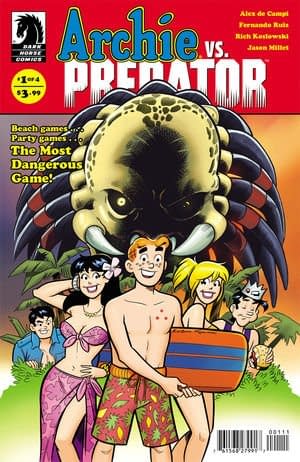
Archie Vs. Predator #1 is the comic for you!
Let me get this out there, I've never been a huge fan of Archie comics. Never was the demographic they were going for but over the years, Archie has, arguably, become one of comics' most progressive publishers, having taken on Riverdale's richest 1%, killed Archie in an alternate reality and introduced their first disabled and gay characters to the cast.
This July, after nearly 75 years of Archie's shenanigans, it all comes to an end; replaced soon by a new ongoing series written by fan-favorite Mark Waid (Daredevil) and superstar artist Fiona Staples of Saga fame.
Before Archie, as we knew him goes away, there's one more thing to do: take one of the 80's greatest movie creations, and set him loose upon the Riverdale population.
Another spring break and the Riverdale gang are at a loss for what to do with it. There's always tubing, camping or… stuff. The ever-hungry Jughead opens a bag of potato chips, wins a trip to the Caribbean for what seems like the whole town and a bunch of horny teens go away unaccompanied in the jungle. The ever popular Cheryl Blossom is the first to enter the jungle and soon, the gang from Riverdale will walk into a canopy of trees and become drenched in the blood of one of their own. On their way home they will bring home a lone passenger; one always on the hunt, always ready to separate spine from body.
Archie Vs. Predator #1 is just a ridiculous, ridiculous thing and writer Alex de Campi knows it and delights in it. She knows no real explanation is needed for this thing to be happening so why not potato chips in order to bring a Predator to Riverdale? In AvP #1, de Campi creates the ultimate 80's mash-up using the Riverdale gang as the inevitably dead teens found in every 80's slasher flick pitting them against one of the 80's greatest killing machines. The dialogue is equally ridiculos and at times, kinda bawdy but hey, if you came only for rainbows and high-fives, you're kinda missing the point of an Archie Vs. Predator comic.
Artist Fernando Ruiz brings it all to you in the traditional Archie style of big eyes and over-expression and it's a glorious thing. This issue is very light on actual Predator but very high in Archie and Ruiz masterfully uses The Predator's thermal point-of-view to illustrate his continued but rarely seen presence throughout the comic. In this comic, they enter his world and not the other way around.
Archie Vs. Predator #1 is a comic filled with lustful teens who, at times, don't seem to like each or themselves very much. Now, I don't know if that's some grand statement on Archie comics but I'll be honest… I'm kinda rooting for The Predator in this one.
Godzilla: Rulers of Earth Vol. 5 (IDW, $17.99)
By Cat Taylor

This Godzilla series is so loaded with Kaiju that I felt like I was reading the comic book version of Godzilla: Final Wars. It's definitely a "throw in everything but the kitchen sink" kind of story, just like Final Wars but given the unlimited time a comic series has to tell the story, the writer, Chris Mowry, is more effectively able to give each Kaiju its time to shine. In this volume, even the giant lobster, Ebirah is able to give Godzilla a tough fight. So, there's the strength of telling a mega-Kaiju battle in comics form. The weakness though, is that no matter how well the fights are illustrated, and they are illustrated beautifully with a pop-art style by Matt Frank and Jeff Zornow, and vibrant colors by Priscilla Tramontano that make the energy blasts actually appear to be glowing, I felt like I was missing the main part of any Godzilla story. Of course I'm referring to actually watching the Kaiju battle. Still pictures just can't measure up to motion when the monster fights are the main attraction. Unfortunately, that's always going to be a weakness of any motion-less Godzilla adaptation.
Despite that obvious weakness, this series "gets" what people love about Godzilla better than Marvel or Dark Horse ever did. It's about Kaiju battles, not about people wringing their hands over what to do about Godzilla. Okay, the original Godzilla movie, or Gojira, was more about the people with Godzilla as an obstacle, but the series beyond that has been something entirely different. Plus, the original movie was perfection that can't be duplicated or imitated effectively, especially in comic books. IDW's "go to" licensed property writer, Mowry, knows what they need to do with this property and how to do it. I'll never take Godzilla comics over the movies, but I'll be glad to have them as supplements while waiting for the next feature film.
Cat Taylor has been reading comics since the 1970s. Some of his favorite writers are Alan Moore, Neil Gaiman, Peter Bagge, and Kurt Busiek. Prior to writing about comics, Taylor performed in punk rock bands and on the outlaw professional wrestling circuit. During that time he also wrote for music and pro wrestling fanzines. He knows these facts don't make him more credible as a comic book reviewer, but he was told to write a brief bio for his reviews. So, there you go. You can e-mail Cat at cizattaylor@hotmail.com.










